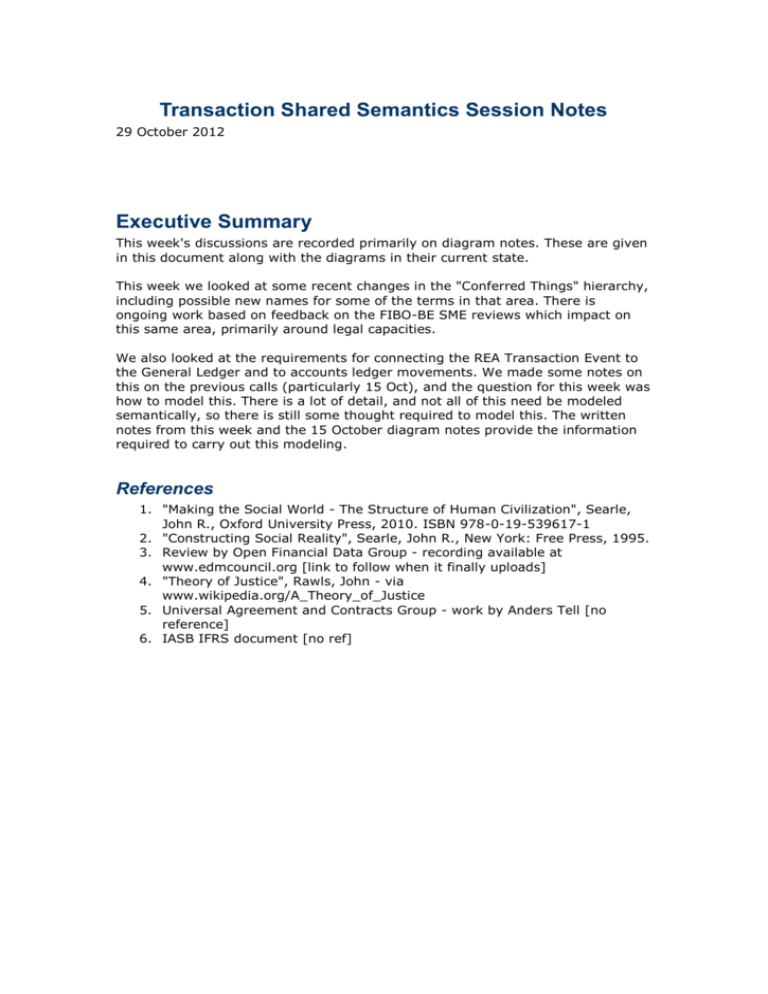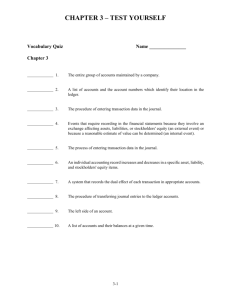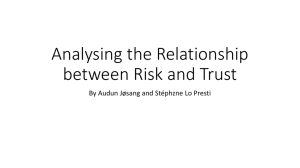Shared Semantics session notes 29 October 2012
advertisement

Transaction Shared Semantics Session Notes 29 October 2012 Executive Summary This week's discussions are recorded primarily on diagram notes. These are given in this document along with the diagrams in their current state. This week we looked at some recent changes in the "Conferred Things" hierarchy, including possible new names for some of the terms in that area. There is ongoing work based on feedback on the FIBO-BE SME reviews which impact on this same area, primarily around legal capacities. We also looked at the requirements for connecting the REA Transaction Event to the General Ledger and to accounts ledger movements. We made some notes on this on the previous calls (particularly 15 Oct), and the question for this week was how to model this. There is a lot of detail, and not all of this need be modeled semantically, so there is still some thought required to model this. The written notes from this week and the 15 October diagram notes provide the information required to carry out this modeling. References 1. "Making the Social World - The Structure of Human Civilization", Searle, John R., Oxford University Press, 2010. ISBN 978-0-19-539617-1 2. "Constructing Social Reality", Searle, John R., New York: Free Press, 1995. 3. Review by Open Financial Data Group - recording available at www.edmcouncil.org [link to follow when it finally uploads] 4. "Theory of Justice", Rawls, John - via www.wikipedia.org/A_Theory_of_Justice 5. Universal Agreement and Contracts Group - work by Anders Tell [no reference] 6. IASB IFRS document [no ref] Transaction Shared Semantics Session Notes 29 Oct 2012 CONTENTS Executive Summary ..................................................................................... 1 References .............................................................................................. 1 Discussion Summary ................................................................................... 3 Changes and proposed new names for Conferred Things ............................... 3 Searle .................................................................................................. 3 Conferred Thing..................................................................................... 3 Right, Obligation.................................................................................... 3 Reflecting Transaction Events in GL ............................................................ 4 Basic Premise ........................................................................................ 4 Diagram Notes ............................................................................................ 5 Diagrams with Notes ................................................................................. 5 Verbatim Diagram Notes ........................................................................... 5 REA Working Diagram Fragment - Aspects ................................................ 5 Page 2 of 7 Transaction Shared Semantics Session Notes 29 Oct 2012 Discussion Summary Discussed changes in the "Conferred Things" area How to reflect transaction events on the GL Changes and proposed new names for Conferred Things Searle Looking at Searle [1]. Have not yet completely digested this, but Searle addresses many of the same issues we have considered both in business entities and in the formal modeling of rights, obligations and commitments (relevant to REA alignment). In particular (page nos in Ref 1): Creating a Corporation - p97 Rights as deontic powers - p176-177 and adjacent o On p177: "All Rights Imply Obligations" Based on this work, we should be able to represent social constructs as real-world, first order / independent things. This is very much in line with what we have been trying to do, and would add a degree of rigor to these. In the mean time, this gives us a degree of confidence in our "Conferred Thing" taxonomy, though the labeling and taxonomic structure may change. Also our rendering of rights and obligations as somehow mutual, is directly in line with Searle, though we have yet to see if he would model these as first-order, independent constructs with some mutuality between them, or as complementary aspects of the same thing as we have done. Conferred Thing Changed the name to "Social Construct". However, the thing we have defined here is something that is conferred by one of law, contract or constitution, which is almost certainly narrower than social constructs more generally, so most likely our term Conferred Thing is a sub-type of this. Review: Is there a better name for this and should it be a sub-type of Social Construct? No suggestions. Since the meeting, I've renamed this to "Deontic Construct" for now. Right, Obligation The archetypes of all of these changed to "Perspectival" i.e. Aspect. MB Tentatively renamed these to "Contingent Right", "Contingent Obligation" to reflect that these are aspects of something. Consensus: No. Change it back. Page 3 of 7 Transaction Shared Semantics Session Notes 29 Oct 2012 Reflecting Transaction Events in GL Basic Premise As noted last time, at the point at which a Transaction Event ends, it hits the General Ledger. What is the nature of this connection and how best can it be modeled? Discussion on this is captured in the on-screen diagram notes that are replicated in the next section. Page 4 of 7 Transaction Shared Semantics Session Notes 29 Oct 2012 Diagram Notes Diagrams with Notes REA Working Diagram Fragment - Aspects All our discussions were recorded on this diagram. Also looked at Financial section diagrams, for the term for "Account". Added this, and REA Transaction Event, to the diagram above. Verbatim Diagram Notes REA Working Diagram Fragment - Aspects Transaction Event and Accounts Ledger Entry Next modeling challenge: model the relationship between Transaction Event and Accounts Ledger Entry How do Right and Obligation relate to Liability and Asset? Page 5 of 7 Transaction Shared Semantics Session Notes 29 Oct 2012 Liability and Asset in the accounts v Right and Obligation as views of Commitment Capturing the change of state in the termination of the Transaction Event Therefore: change of state is for example changes in the entitlement to something e.g. in accrual - to meet matching principles, you record the thing as it earned versus record when it is due (different classifications, represent the various states that an asset can be in. This means, we record the states of an asset, and the journal is moving assets around the ledger. In general: changes in the ledger are reflecting changes in the disposition of the various assets, liabilities and (per Accounts Equation) Equity. How to model change of state, effect on GL? How to model this? About equity: it's the liability of the organization you are measuring, to the owner of the organization. Rights and Obligations versus Assets and Liabilities How do these compare? Assets: not exclusively rights. Might record an asset directly OR one's entitlement to that asset. A liability is an obligation to deliver some asset to someone else. SO: Liability is co-extensive with Obligation. Commitment Parts 4 parts not 2 in Commitment: Obligor has an obligation to deliver Obligor has a right to deliver Obligee has a right to receive Obligee has an obligation to receive. These are diagonally related - although half of these are unlikely but logically possible / implied. This results in a symmetry. Treat any single position (security, or cash) as having a balance sheet and P&L of its own. If you move from e.g. cash to a position in e.g. IBM Ordinary Shares: Initially, shareholder funds are the liability, but you can take that down to the individual level. Account for how you treat the various accrued components. Cost of txns etc. -so you move from Cash to the position in IBM O shares - runs at a loss because of the txn costs - so you have a liability (cost of investment) and the asset (the value immediately upon txn), which is what you have. Then, over time the value of the asset changes. The txn explicitly involved the transformation of one Page 6 of 7 Transaction Shared Semantics Session Notes 29 Oct 2012 asset into another. A measure of Pf performance is "money weighted rate of return" i.e. take what was the $ cost, and carry this through the life of the asset, as effectively 'what the asset owed to fund it'. Implications of this Extends ledger to assets / allocation of assets. Consider: what's the state of assets? Expectations versus what I am entitled to. When it falls due - move from accrue to receivable. These are the state transitions. Moving from one ledger to another (see last week's note on heteronym for Transaction). The actual external txn is a sub-set of the txns that might appear in the ledger. It's also a different kind of thing. See e.g. IFW: also makes the distinction. Has "Transaction Event" (the real txn i.e. Economic Event) and a separate thing called "Entry Event" which is the recording of the representation of that txn event. Entry Event - continued from above note Entry Event - seems to be synonym for what we talked about last time. Distinguishes between: Post Entry Maintenance Entry (a) is simple credit and debit (b) reflects a state change in a more complex data structure representing the txn as an arrangement. This is the concept that corresponds to the heteronym term sometimes called "Transaction" but being a ledger transaction not an economic transaction (and, as previously agreed, not modeled under REA-derived constructs) Transaction Event and Accounts Ledger Entry Initial Recognition event is the relationship that goes between these two classes. Paper to follow (from Kieran) based on IFRS 39. What happens between the Txn Event and the posting activities, is the application of the relevant accounting rules. Simple model: one event leads to multiple postings The complex model is what those postings are and the rules that lead to them. Page 7 of 7







